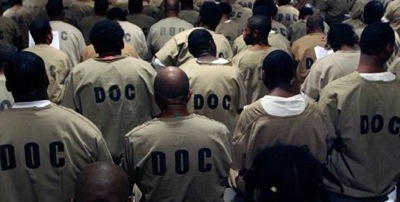Photo: Southercoalition.org
For forty years the United States has hidden the consequence of its tragic racial history at the center of the War on Drugs.
That historical consequence has now hardened into a box of mass incarceration that has trapped Black America. This proverbial box is so full it is now bursting at the seams, and seeping out are the screams of men like Eric Garner and countless others that simply cannot breathe under its pressure.
A past riddled with repetitive efforts to create a class-based system divided by color has been recast through a lens of criminalization. The lasting effects of longstanding racially-biased policies hidden away in boxes of steel, locked behind prison bars across this nation are the lives that prove this point.
The faces in large part are Black, but just as important are the legacies behind these lives. These prisoners of this war are marked not just because of their dark skin color, but also because held within their American familial lineage is a cycle of bondage that has come in several different forms.
From an era of chattel slavery that lasted into the early 20th century, to an extensive period that followed during which many African American men existed in a slave-like status as prison labor during a period of convict leasing, the use of criminality to reform bondage in a more acceptable frame was finally perfected through the War on Drugs.
You must look along both historical and economic lines to understand the roots of mass incarceration. The foundation began in the 1600’s with the use of slavery to subjugate, and that form of bondage existed for hundreds of years. It was followed by implementation of Jim Crow laws, creating a period of color-based separation of advantage and opportunity that lasted well into the early 1970’s.
Then almost immediately after the social transformation created by the Civil Rights movements a change in incarceration methodology transpired. In 1983, when Corrections Corporations of America took over its first facilities in Houston, Texas a new era of incarceration was ushered into existence. What people often fail to recognize is how during Reagan’s first term the start of a resurgence in private prisons occurred. Followed by the implementation of laws, such as the Anti Drug Abuse Act of 1986 requiring mandated sentences for crack cocaine sales, at the local and national level, those newly-minted private prisons were fed the lives of Black descendants of slavery at unprecedented rates.
Over the past several years I have worked with Marc Levin and several other producers to create the documentary “Freeway Crack in the System” to provide the definitive story on the War on Drugs. As stated by Levin on the Daily Beast:—“How did we get from the glorious battles of the Civil Rights Movement to the devastation of the crack plague? From the police crackdown on the marchers on the Selma bridge to the police killings of Michael Brown and Eric Garner? From the nonviolence movement of courageous civil rights activists to the gang violence that has made homicide the number one cause of death for young black men? And finally from the impassioned eloquence of Dr. King’s ‘I have a dream’ to the drug kingpin’s ‘I have a life sentence?’
The War on Drugs… “”Freeway Crack in the System”” is the story that rocked black America and led to all sorts of conspiracy theories and urban legends. It is also the story that goes to the fundamental hypocrisy and corruption of this failed War on Drugs.”–A Drug Kingpin, the CIA, and Prisoners
This box of mass incarceration not only trapped Black America, but it also mutated its social development. Inside of this newly-minted box developed the iconization of the infamous criminal mastermind, personified by the image of Rick Ross. His persona — the epitome of the antihero; part crack, part rap, and all controversial. Mass incarceration had commandeered Black masculinity and returned it back to the Black community as a shell of its former self. Stacy Adams dress shoes became overpriced Jordans, and three-piece suits became white tees coupled with Louis Vuitton belts holding up designer jeans with empty pockets.
Fueled by hip-hop culture’s folklore-type messaging, the box that trapped Black America was rewrapped like a present on Christmas. Draped in decadent riches, this box’s destructive innards were hidden by million dollar Roc-A-fella record deals, and the promise to make it out of the hood and escape with a rock star image. Yet trapped inside the beautifully trimmed box was a reality of the consequence that comes with positioning a singular subgroup of young Blacks in such a juxtaposed reality. The cost of which has been borne by: Trayvon Martin; Mike Brown; Jordan Davis; and, many others that were caught in the darkness of this box’s shadow.
Before the implementation of crack cocaine sentencing and the privatization of prisons in the mid 1980s, Black male prison rates hovered around the range of 1,000 per 100,000. Since then, the rate has risen to numbers never seen in modern history. Fueled by changes in drug sentencing and inclusion of minor crimes within the umbrella of imprisonable offenses, such as child support violations and driving with a suspended license the number of Black males incarcerated skyrocketed.
(Note: The ratio for young black male imprisonment is around 10 percent, or about 10,000 prisoners per 100,000. During South African apartheid, one of the most horrific instances of racism the world has seen, the prison rate for Black male South Africans, under immensely unfair laws, was 851 per 100,000. In America today, young Black men face a rate of imprisonment effectively ten times that number.)
The consequences these high imprisonment rates have had on the social development of the black family are immeasurable. Initially you are drawn to see the irony of a group whose ancestors endured slavery and Jim Crow being funneled back into incarceration at such high rates. But, the less obvious result is a massive decrease in working age Black men that are actually participating in the workforce.
Black America can ill-afford to have a third of their working age men go to jail at some point in their life. This absence has resulted in an epidemic of broken homes, and far too many Black children being raised without a father. Policy makers talk as if sentencing changes will fix what was taken economically when the Black community lost so many of its working age Black men to the drug war — it will not; focused economic policy is needed to repair the Black community. In addition a demand to evaluate the impact of private prisons on incarceration rates must be demanded.
Privatization made imprisonment a business. That business of imprisonment needed occupants, and no group felt that impact more readily than young Black men. This model fundamentally changed the role of imprisonment in communities from one of punishment, to one burdened with the complexities of economics.
In the piece 6 shocking revelations about how private prisons make money Salon.com reported, “In a letter to 48 state governors in 2012, the largest for-profit private prison company in the US, Corrections Corporation of America (CCA), offered to buy up and operate public state prisons. In exchange, states would have to sign a 20-year contract guaranteeing a 90 percent occupancy rate throughout the term.”
A government cannot know how many people will go to prison before hand, nor can it conscionably entertain a commitment to any quota of occupancy. For there to even be a proposal of this sort reflects how much our society’s view of criminalization has changed in the years following the ramping up of the War on Drugs.
Cornel West in his New York Times piece, “Dr. King Weeps from his Grave” stated “Racism is a moral catastrophe, most graphically seen in the prison industrial complex and targeted police surveillance in black and brown ghettos rendered invisible in public discourse.” This box of mass incarceration that lies at the center of the War on Drugs has suffocated Black American families with that catastrophe. If left intact it may in the end trap all of America.
The commentary was first published on TheGriot
Antonio Moore is a Los Angeles based entertainment attorney with several celebrity clients. In recent years he has worked as a producer on the documentary on the Iran Contra & Crack Cocaine Epidemic “Crack in the System” premiering at 10PM on Al Jazeera Part I March 1 & Part 2 March 8. The film is scheduled to be screened March 8, and close the events in Selma, Alabama after a historic reenactment on the Pettus Bridge.
President Barack Obama is also scheduled to give a speech in Selma the same weekend to commemorate the events of Bloody Sunday that occurred on the Edmund Pettus Bridge 50 years ago. Facebook and Instagram









